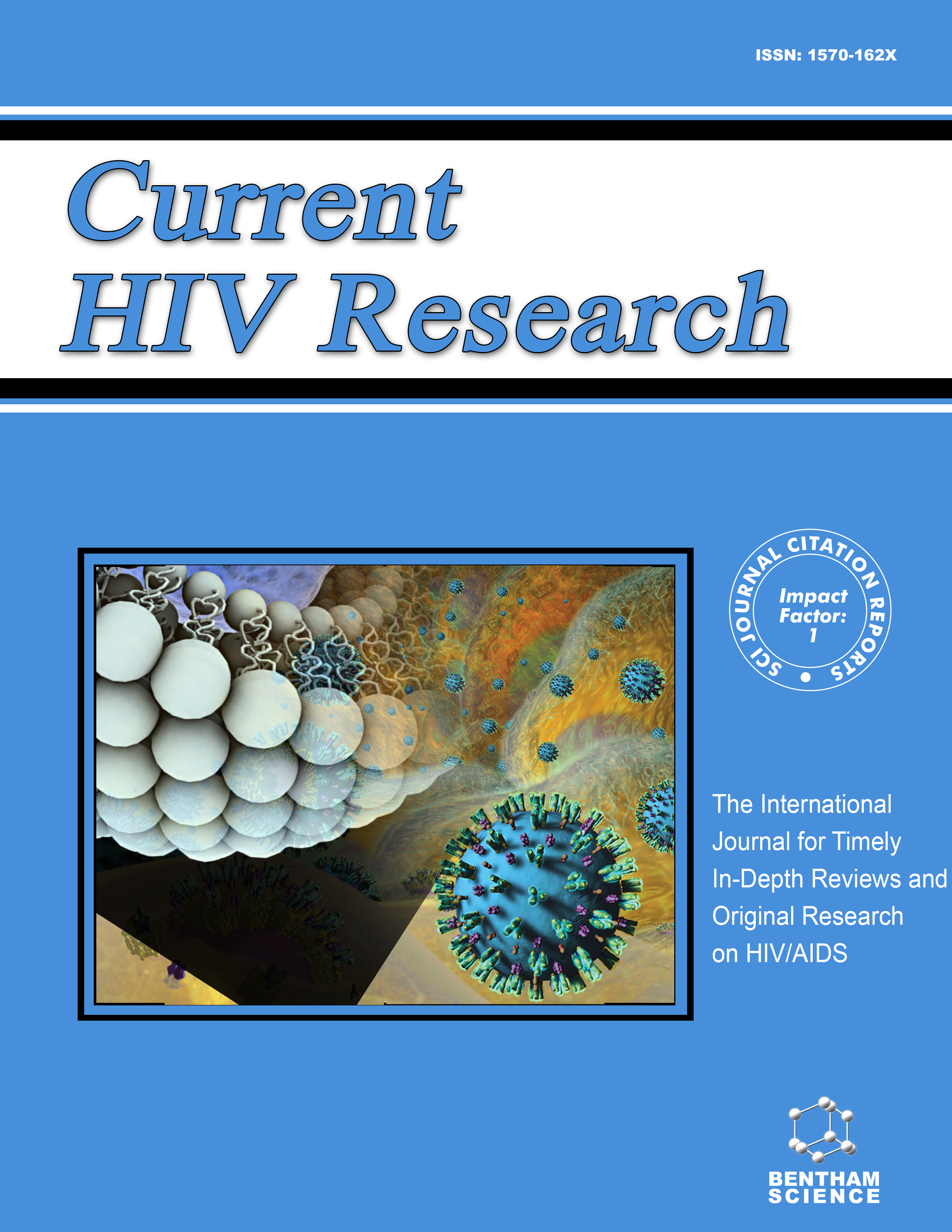- Home
- A-Z Publications
- Current HIV Research
- Previous Issues
- Volume 8, Issue 6, 2010
Current HIV Research - Volume 8, Issue 6, 2010
Volume 8, Issue 6, 2010
-
-
Bryostatin-1 Synergizes with Histone Deacetylase Inhibitors to Reactivate HIV-1 from Latency
More LessThe persistence of latent HIV-infected cellular reservoirs represents the major hurdle to virus eradication on patients treated with HAART. It has been suggested that successful depletion of such latent reservoirs will require a combination of therapeutic agents that can specifically and efficiently act on cells harboring latent HIV-1 provirus. Using Jurkat-LAT-GFP cells, a tractable model of HIV-1 latency, we have found that Read More
-
-
-
Preventing HIV Transmission in Married and Cohabiting HIV-Discordant Couples in Sub-Saharan Africa through Combination Prevention
More LessMost new HIV infections in sub-Saharan Africa now occur in married and cohabiting couples, many of whom do not realize that only one of them may be infected with HIV. HIV-negative individuals living in stable HIV-discordant partnerships (in which one partner is HIV-infected while the other one is not) are twice as likely to get infected with HIV as those living in concordant HIV-negative relationships. Since HIV transmission oc Read More
-
-
-
An Effective HIV Vaccine: A Combination of Humoral and Cellular Immunity?
More LessAuthors: Sihame Benmira, Vish Bhattacharya and Matthias L. SchmidThe development of a safe and effective HIV vaccine remains the best hope to control the global HIV epidemic. So far, the different strategies tried for vaccine development have led to disappointing results. The first attempted strategy involved trying to raise neutralizing antibodies to inactivate the virus and prevent infection. Both of Vaxgen's VAX004 and VAX003 phase 3 trials made use of this approach but ultimately failed. Giv Read More
-
-
-
Cutaneous Markers of HIV Infection and Progression
More LessSkin and mucosal diseases can be the first manifestation of asymptomatic HIV infection, may indicate advancing immunodeficiency, or may represent systemic opportunistic infections or neoplasms. Mucocutaneous diseases are highly prevalent in the HIV-infected population and multiple pathologies are common particularly with advanced immunosuppression. The dominant HIV-associated skin diseases are infectious and i Read More
-
-
-
Comparison of Protease Inhibitor (PI) Resistance-Associated Mutations Between PI-Naive and PI-Experienced HIV-1 Infected Patients in Thailand Where Subtype A/E is Predominant
More LessProtease inhibitor (PI) resistance-associated mutations (RAMs) are commonly observed in PI-naive patients who are infected with HIV-1 subtype A/E. Few data are available on the genetic mechanisms of PI resistance in non-B HIV-1. This study was aimed to compare PI-RAMs between PI-naive and -experienced patients and determine PI resistance in each group. Genotypic resistance testing was conducted among a cohort of HIV-1-i Read More
-
-
-
Immunogenicity and Tolerability of Yellow Fever Vaccination in 23 French HIV-Infected Patients
More LessBackground: Vaccination of asymptomatic human immunodeficiency virus (HIV)-infected patients with a CD4 cell count ® 200/mm3 is strongly suggested prior to travel to a region where yellow fever (YF) is endemic. However, few data describing YF vaccination in such patients are available. Methods: In this retrospective observational study of 23 HIV-infected patients, YF antibody titers, CD4 cell counts, and viral loads were m Read More
-
-
-
Saquinavir/Ritonavir Monotherapy as a New Nucleoside-Sparing Maintenance Strategy in Long-Term Virologically Suppressed HIVInfected Patients
More LessBackground: The high antiviral potency and low toxicity of saquinavir/ritonavir (SQV/r) prompted us to assess a viable strategy in chronic virologically suppressed HIV-infected patients. Methods: A randomized, multicenter pilot trial. Patients taking triple HAART with (VL <50 copies/mL) and no history of virological failure with a protease inhibitor (PI) or PI-related resistance were assigned in a 2:1 ratio to receive SQV 100 Read More
-
-
-
High Levels of CD57+CD28- T-Cells, Low T-Cell Proliferation and Preferential Expansion of Terminally Differentiated CD4+ T-Cells in HIVElite Controllers
More LessThe study of clinical and demographic characteristics related to virus control and disease progression in patients who spontaneously control HIV vireamia (HIV-controllers) is of major interest. A particular cause of HIV control has not been found and the scenario could be partially explained by special homeostatic and immunological features. In this study, CD57+CD28- phenotype, T-cell activation and levels of proliferating T-cell Read More
-
-
-
Long-Term Immunovirogical Effect and Tolerability of a Maraviroc- Containing Regimen in Routine Clinical Practice
More LessObjectives: to analyze the long-term immunovirological effect and tolerability of a maraviroc-containing antiretroviral therapy in viraemic and pretreated HIV-infected patients with a high prevalence of hepatitis C virus (HCV) coinfection. Methods: forty-six R5 HIV-infected patients (48% HCV-coinfected) started a maraviroc-containing antiretroviral regimen, including patients with multidrug resistant virus and patients after firs Read More
-
-
-
Immunophenotype of Vitamin D Receptor Polymorphism Associated to Risk of HIV-1 Infection and Rate of Disease Progression
More LessVitamin-D-receptor (VDR) mediates immunomodulatory effects of vitamin-VD3 (VD3). The VDRrs1544410_ GG polymorphism has been associated with delayed progression rates to AIDS and resistance to HIV-1 infection. The aim of the present study was to investigate differences in VD3 mediated effects on rs1544410 genotyped dendritic cells (DCs) and macrophages (MDM), key cells involved in HIV-1 infection. Immature Read More
-
Volumes & issues
-
Volume 23 (2025)
-
Volume 22 (2024)
-
Volume 21 (2023)
-
Volume 20 (2022)
-
Volume 19 (2021)
-
Volume 18 (2020)
-
Volume 17 (2019)
-
Volume 16 (2018)
-
Volume 15 (2017)
-
Volume 14 (2016)
-
Volume 13 (2015)
-
Volume 12 (2014)
-
Volume 11 (2013)
-
Volume 10 (2012)
-
Volume 9 (2011)
-
Volume 8 (2010)
-
Volume 7 (2009)
-
Volume 6 (2008)
-
Volume 5 (2007)
-
Volume 4 (2006)
-
Volume 3 (2005)
-
Volume 2 (2004)
-
Volume 1 (2003)
Most Read This Month
Article
content/journals/chr
Journal
10
5
false
en


